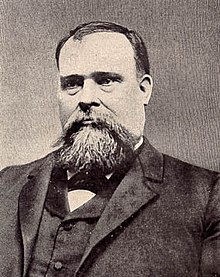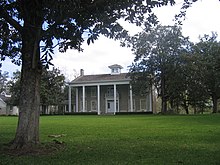Ima Hogg
She restored and refurbished several properties, including the Varner plantation and Bayou Bend, which she later donated to Texas arts and historical institutions who maintain the facilities and their collections today.
Between 1899 and 1901, Hogg attended the University of Texas at Austin; she then moved to New York City to study piano and music theory for two years.
The discovery of oil on her family's cotton plantation made Hogg very wealthy, and she used this income to benefit the people of Texas.
In 1929, she founded the Houston Child Guidance Center, which provided counseling for children with mental health problems or diagnoses and their families.
Hogg successfully ran for a seat on the Houston School Board in 1943, where she worked to remove gender and race as criteria for determining pay and established art education programs for black students.
[9] Ima Hogg later recounted that "my grandfather Stinson lived fifteen miles [24 km] from Mineola and news traveled slowly.
"[4] During her childhood, Hogg's elder brother William often came home from school with a bloody nose, the result of defending, as she later recalled, "my good name.
Ima and her siblings were expected to help renovate the building to a liveable state—she was required, among other things, to pry chewing gum from the furniture and door moldings.
[27] The children liked animals, and their menagerie included dogs, cats, birds, raccoons, opossums, rabbits, a Shetland pony and a parrot.
[29] In later years, the family added a bear, a horse, a fawn, cockatoos, and two ostriches named Jack and Jill to their collection of animals.
[32] In 1895, Sarah was diagnosed with tuberculosis, and on the recommendation of her doctor, she and Ima moved to Colorado, where they lived with Jim Hogg's elder sister, Martha Francis Davis.
[41] After two years of study in New York City, Ima Hogg returned to Texas, dividing her time between the plantation and Houston, where her father had a law practice.
[49] By 1913, Hogg had become president of the Girls' Musical Society and was on the entertainment committee of the College Women's Club, which organized a small theater group known as the Green Mask Players.
[61] Ima was convinced that her youngest brother, Tom, would have benefited from similar intervention, as he had reacted badly after their mother's death and as an adult was "restless, impulsive, and alarmingly careless with money".
[49][68] By the summer of 1923 Hogg was fully recovered,[68] but she permanently discarded her dream of being a concert pianist, ostensibly because of weakness after her illness.
In 1940, after discussion with her brother Michael—the executor of the will—Hogg used the money to establish the Hogg Foundation for Mental Health at the University of Texas at Austin.
[76][77] She researched the early American furniture market extensively, personally visiting Luke Vincent Lockwood, the author of the standard work on the topic, for more information.
[77] At the time, Hogg was one of a small number of people who believed that American antiques had value—by contrast, most collectors concentrated on furniture built in Europe.
As her collection grew, she was often asked to loan pieces for exhibit in New England; Hogg always refused, stating "they've got plenty of these things up there".
[86] Although Hogg spent little time at the Varner plantation after Bayou Bend was constructed, she continued to purchase art and antique furniture on its behalf.
[89] As the Varner–Hogg restoration wound to a halt, Hogg refocused her attention on her Houston home, Bayou Bend,[90] which housed some of her personal collection of antiques and artwork.
[95] Several residents of River Oaks sued to prevent Bayou Bend becoming a museum, but Hogg prevailed in court.
[96] To alleviate the residents' concerns over increased traffic, she asked the city of Houston to build a footbridge over Buffalo Bayou so that visitors could reach the house without having to drive through River Oaks.
[104] Her biographer Bernhard described her as "elegantly and stylishly dressed", 5 feet 2 inches (157 cm) tall and of fair complexion,[105] "independent and self-possessed"[53] and noted that she could "sugarcoat her single-mindedness with layers of charm".
While she was en route, Archduke Franz Ferdinand of Austria was assassinated, and the day before she arrived, Britain declared war on Germany.
For instance, at a concert arranged by the Houston Symphony for her 90th birthday featuring the elderly pianist Arthur Rubinstein,[74] he characterized her as a "tiresome old woman".
She was described by the University of Houston as "compassionate by nature", "progressive in outlook", "concerned with the welfare of all Texans", a "zealous proponent of mental health care" and "committed to public education".
[118] In 1969, she became the third woman (after Lady Bird Johnson and Oveta Culp Hobby) invited to become a member of the Academy of Texas, a society which recognized efforts to "enrich, enlarge or enlighten" knowledge in any field.
The National Society of Interior Designers named her to their International Honors List in 1965 and in 1972 presented her with their Thomas Jefferson Award for her contributions to cultural heritage.
[120] The Dolph Briscoe Center for American History at the University of Texas at Austin presents an annual Ima Hogg Award for Historical Achievement.








